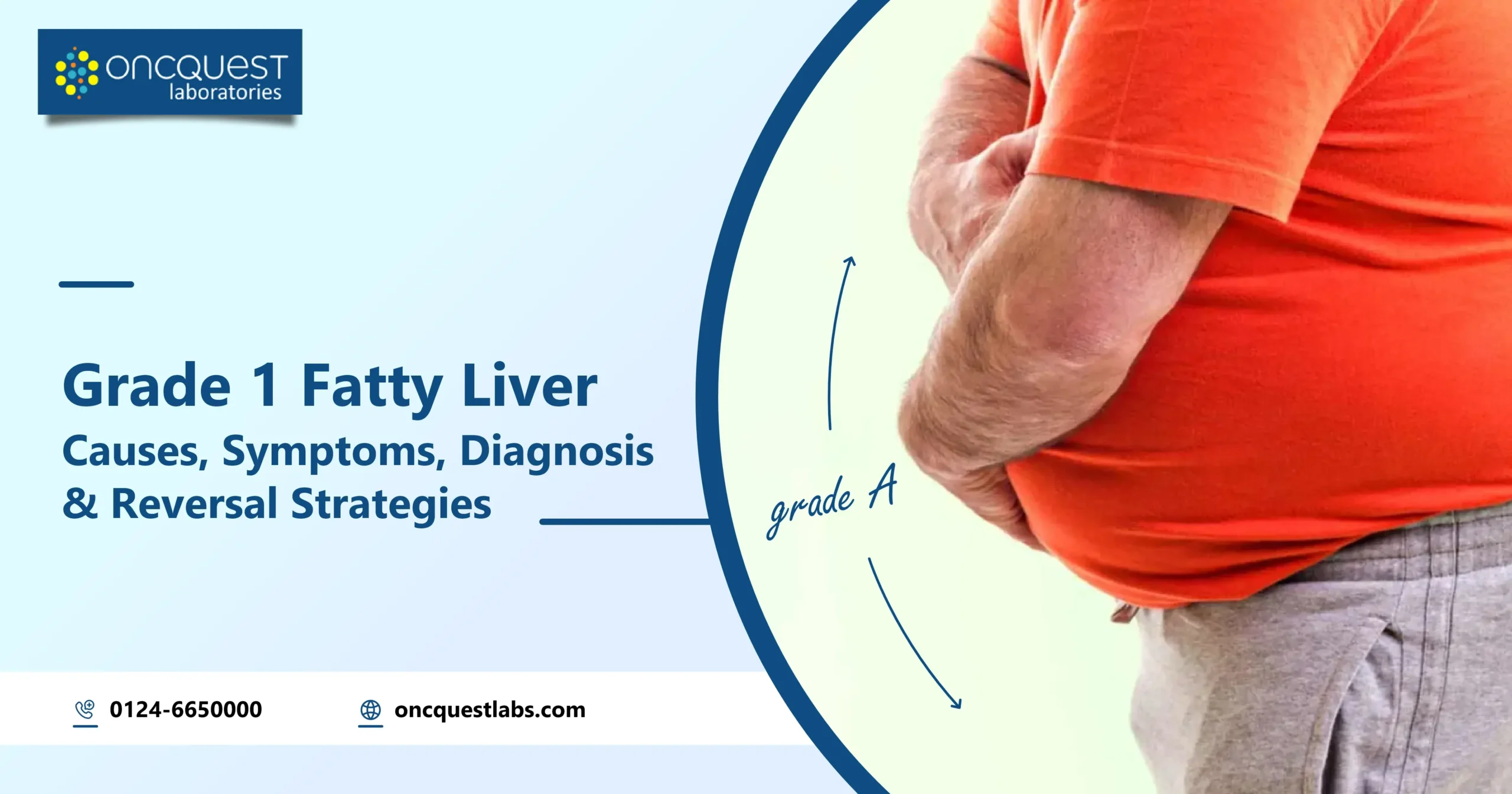Hey there! Ever heard about Grade 1 Fatty Liver? It might sound a bit complicated, but don’t worry – we’re here to break it down in simple terms. Imagine your liver like a hardworking superhero in your body. Sometimes, it can get a bit overloaded with fat, and that’s what Grade 1 Fatty Liver is all about.
In this blog, we’re going to chat about what causes it, the signs your body might be giving you, how doctors figure it out, and most importantly, ways to make your liver superhero healthy again. So, if you’re curious to know more about keeping your liver in top shape, stick around for some easy-to-understand info!
Contents
What is Grade 1 Fatty Liver?
Grade 1 Fatty Liver is a condition where there is an accumulation of excess fat in the liver cells. It’s the mildest form of fatty liver disease and is often considered a reversible condition. In Grade 1 Fatty Liver, the excess fat doesn’t cause significant inflammation or damage to the liver, but it’s essential to address it early to prevent potential progression to more severe liver issues. Lifestyle changes, such as adopting a healthy diet and regular exercise, are commonly recommended to manage and reverse Grade 1 Fatty Liver.
Symptoms of Grade 1 Fatty Liver?
Grade 1 Fatty Liver typically doesn’t present with noticeable symptoms in its early stages. However, as the condition progresses, some individuals may experience:
1. Fatigue: Feeling tired or lacking energy.
2. Discomfort in the upper right abdomen: Mild discomfort or a feeling of fullness.
3. Elevated liver enzymes: Detected through blood tests.
It’s important to note that these symptoms are general and may be associated with various health conditions. If you suspect you have Grade 1 Fatty Liver or experience persistent symptoms, it’s crucial to consult a healthcare professional for a thorough evaluation and appropriate guidance.
Causes of Grade 1 Fatty Liver?
The causes of Grade 1 Fatty Liver are often linked to lifestyle and dietary factors. Some common contributors include:
1. Unhealthy Diet: Consuming a diet high in processed foods, sugars, and saturated fats can contribute to fat accumulation in the liver.
2. Obesity or Overweight: Being overweight or obese increases the likelihood of developing fatty liver disease.
3. Insulin Resistance: Conditions like type 2 diabetes or insulin resistance can be associated with Grade 1 Fatty Liver.
4. High Cholesterol: Elevated levels of cholesterol can contribute to the accumulation of fat in the liver.
5. Rapid Weight Loss: Losing weight too quickly can lead to the release of fatty acids into the liver, contributing to fat accumulation.
6. Genetic Factors: Some genetic factors may play a role in predisposing individuals to fatty liver disease.
It’s often a combination of these factors that contributes to the development of Grade 1 Fatty Liver. Making lifestyle changes, such as adopting a healthier diet and increasing physical activity, is crucial for managing and preventing the progression of this condition.
Risk Factors for Grade 1 Fatty Liver?
Several risk factors can increase the likelihood of developing Grade 1 Fatty Liver. These include:
1. Obesity or Overweight: Excess body weight, especially around the abdomen, is a significant risk factor.
2. Type 2 Diabetes: Insulin resistance and high blood sugar levels are associated with an increased risk of fatty liver disease.
3. Poor Diet: Consuming a diet high in sugars, saturated fats, and processed foods contributes to the development of fatty liver.
4. Metabolic Syndrome: A cluster of conditions, including high blood pressure, high blood sugar, excess body fat around the waist, and abnormal cholesterol levels, increases the risk.
5. Rapid Weight Loss: Losing weight too quickly can lead to the release of fatty acids into the liver, promoting fat accumulation.
6. Age and Gender: Fatty liver disease is more common in middle-aged individuals, and men tend to be at a higher risk than premenopausal women.
7. Genetics: Family history can play a role, as some genetic factors may increase susceptibility to fatty liver disease.
8. Certain Medications: Some medications, such as corticosteroids and certain anti-retroviral drugs, may contribute to the development of fatty liver.
Understanding these risk factors can help individuals make informed lifestyle choices and take preventive measures to reduce the likelihood of Grade 1 Fatty Liver. Regular medical check-ups and consultations with healthcare professionals are crucial for those with identified risk factors.
Diagnose Grade 1 Fatty Liver?
Diagnosing Grade 1 Fatty Liver typically involves a combination of medical history assessment, physical examination, and diagnostic tests. Here’s an overview of the common diagnostic approaches:
1. Medical History and Physical Examination: The healthcare provider will inquire about your medical history, lifestyle, and any symptoms you may be experiencing. A physical examination may also be conducted to assess the overall health and look for signs of liver issues.
2. Blood Tests: Blood tests are crucial for assessing liver function. Elevated liver enzyme levels and other markers may indicate the presence of fatty liver disease. Blood tests can also help rule out other liver conditions.
3. Imaging Studies:
- Ultrasound: This non-invasive imaging test uses sound waves to create images of the liver. It can identify the presence of fat and assess the degree of liver involvement.
- CT Scan or MRI: These imaging techniques provide more detailed images of the liver and can help in confirming the diagnosis.
4. Transient Elastography (FibroScan): This specialized ultrasound technique measures liver stiffness, helping to assess the degree of liver fibrosis or scarring.
5. Liver Biopsy (in some cases): In certain situations, a small sample of liver tissue may be obtained through a biopsy to assess the extent of liver damage and confirm the diagnosis.
It’s essential to consult with a healthcare professional for an accurate diagnosis and appropriate guidance based on individual health factors. These diagnostic methods help determine the presence and severity of Grade 1 Fatty Liver, guiding subsequent management and lifestyle interventions.
Treatment of Grade 1 Fatty Liver?
The primary focus of treating Grade 1 Fatty Liver involves lifestyle modifications to reduce fat accumulation in the liver and improve overall liver health. Here are key aspects of the treatment:
1. Healthy Diet: Adopting a balanced and nutritious diet is crucial. This includes reducing intake of processed foods, sugars, and saturated fats. Incorporate more fruits, vegetables, whole grains, and lean proteins.
2. Weight Management: Achieving and maintaining a healthy weight is vital. Gradual, sustainable weight loss through a combination of diet and regular exercise is often recommended.
3. Regular Exercise: Engaging in regular physical activity helps burn excess fat and improve insulin sensitivity. Aim for at least 150 minutes of moderate-intensity exercise per week.
4. Controlled Blood Sugar: If there is an underlying condition like diabetes, managing blood sugar levels is essential. This may involve medication, lifestyle changes, or both.
5. Limit Alcohol Consumption: Moderating alcohol intake is advised, as excessive alcohol consumption can contribute to liver damage.
6. Medication (in some cases): While there isn’t a specific medication approved solely for Grade 1 Fatty Liver, healthcare providers may prescribe medications to manage underlying conditions like diabetes or high cholesterol.
7. Regular Monitoring: Routine follow-ups and monitoring of liver function through blood tests and imaging studies may be recommended to assess progress and adjust the treatment plan as needed.
It’s crucial for individuals with Grade 1 Fatty Liver to work closely with healthcare professionals to tailor a treatment plan based on their specific health needs. Consistent adherence to lifestyle changes and ongoing monitoring are key elements in managing and potentially reversing this condition.
Reversal Strategies for Grade 1 Fatty Liver?
Reversing Grade 1 Fatty Liver involves implementing lifestyle changes to reduce fat accumulation in the liver and promote overall liver health. Here are effective reversal strategies:
1. Healthy Diet: Adopt a well-balanced diet rich in fruits, vegetables, whole grains, and lean proteins. Limit intake of processed foods, sugars, and saturated fats.
2. Weight Management: Achieve and maintain a healthy weight through gradual, sustainable weight loss. This is often achieved through a combination of a balanced diet and regular exercise.
3. Regular Exercise: Engage in regular physical activity to help burn excess fat and improve insulin sensitivity. Aim for at least 150 minutes of moderate-intensity exercise per week.
4. Hydration: Drink an adequate amount of water daily to support overall health and assist in liver function.
5. Limit Alcohol Consumption: Moderation or complete avoidance of alcohol is recommended, as it can contribute to liver damage.
6. Controlled Blood Sugar: If you have diabetes or insulin resistance, managing blood sugar levels is crucial. This may involve medication, lifestyle changes, or a combination of both.
7. Omega-3 Fatty Acids: Incorporate sources of omega-3 fatty acids, such as fatty fish, flaxseeds, and walnuts, which may have anti-inflammatory effects on the liver.
8. Antioxidant-Rich Foods: Include foods high in antioxidants, such as berries, spinach, and nuts, to support overall liver health.
9. Limit Processed Foods: Reduce the intake of processed foods, as they often contain unhealthy fats and additives that can contribute to liver issues.
10. Regular Monitoring: Attend regular follow-ups with healthcare professionals for monitoring liver function through blood tests and imaging studies. Adjust the treatment plan as needed based on progress.
It’s important to note that individual responses to these strategies may vary, and consultation with healthcare professionals is essential for personalized guidance and monitoring of progress. Consistent adherence to these lifestyle changes is key to effectively reversing Grade 1 Fatty Liver.
When to See Doctor for Grade 1 Fatty Liver
It’s advisable to see a doctor if you experience any of the following situations related to Grade 1 Fatty Liver:
1. Persistent Symptoms: If you have symptoms like fatigue, discomfort in the upper right abdomen, or unexplained weight loss that persists, it’s important to seek medical advice.
2. Risk Factors: If you have known risk factors for fatty liver, such as obesity, diabetes, or a family history of liver disease, consulting a healthcare professional for preventive care and monitoring is recommended.
3. Abnormal Liver Function Tests: If routine blood tests reveal elevated liver enzymes or other abnormalities, it’s crucial to follow up with a healthcare provider for further investigation.
4. Concerns About Liver Health: If you are concerned about your liver health or have been diagnosed with Grade 1 Fatty Liver, seeking medical guidance is important for a comprehensive evaluation and personalized treatment plan.
5. Medication Side Effects: If you are taking medications known to potentially affect the liver and you notice any adverse effects, consult your doctor promptly.
6. Routine Check-ups: For individuals with risk factors or pre-existing conditions, regular check-ups with a healthcare provider can help monitor liver health and detect any issues early on.
Remember, early detection and intervention can contribute to better outcomes in managing Grade 1 Fatty Liver. Always consult with a healthcare professional for personalized advice based on your specific health status and concerns.
Conclusion
In conclusion, Grade 1 Fatty Liver, marked by fat accumulation in liver cells, necessitates attention to prevent progression. Causes include poor diet, sedentary lifestyle, and obesity. Identifying symptoms like fatigue and abdominal discomfort is crucial for early detection. Diagnostic tools like imaging and blood tests aid in accurate assessment. Reversing Grade 1 Fatty Liver involves lifestyle modifications such as a balanced diet, regular exercise, and weight management. Additionally, avoiding excessive alcohol intake is pivotal. Proactive measures, coupled with medical guidance, can mitigate risks and promote liver health, highlighting the significance of lifestyle interventions in managing this condition effectively.




